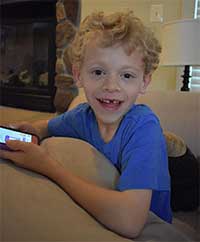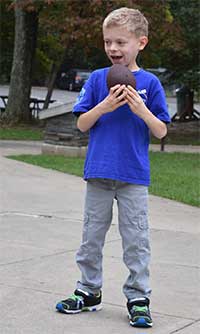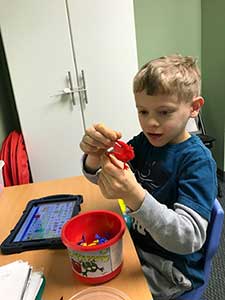We had known something was off from early on. Cameron hadn’t achieved most of his first-year milestones on time and as we searched for answers about a diagnosis, we also coordinated a plan to achieve a long list of goals based on where he was at the time. It would take five years before he was officially diagnosed on the autism spectrum. Within that time period, we consulted dozens of specialists, picking up other diagnoses along the way, including renal agenesis, sensory processing disorder, global development delay, fine motor delays, failure to thrive, small stature, low muscle tone, acid reflux, food sensitivities, mixed receptive-expressive language disorder, speech apraxia and dyspraxia.
The Road Ahead

At first, because Cameron had so much going on, the cadre of doctors and specialists didn’t seem to focus on the fact he couldn’t communicate, other than it was another checkbox of something he couldn’t do. And we were constantly reminded by just about everyone we knew that some kids just take longer to talk: Such and such’s cousin, or sister, or sibling, hadn’t talked until age 3, 5 or 7; we heard stories like this for a long time. His doctors and therapists suggested speech would come when this skill was obtained or that other skill was mastered, but at the age of three we still weren’t seeing any real progress with his vocalizations. He was taking in his world, even babbling – sometimes very loudly – and he even seemed to understand most of what we were saying, but he just didn’t seem to have any interest in talking and his communication to us was minimal. We talked to him non-stop but there was not a return vocal response. And when he did have vocalizations, they were spontaneous and very seldom, if ever, on command.
Like the time I heard him say, “purple.” He wanted a purple crayon, as purple seemed to be his favorite color at the time. And then he said it: purple. Like it was no big deal. I can still hear it in my head. There are times when I wonder if it was all just a dream, although I know it wasn’t because his teacher had heard it at school in several spontaneous situations as well. I remember trying to get him to repeat it and he couldn’t. No matter how hard he tried or I willed it, what came out of his mouth was not the word purple or anything closely resembling it. I think he said it a few more times over the course of a month but never on command. And then, it was gone. It would take a few more years before we had a name for what this was: apraxia of speech. This was when we worked toward figuring out how to work around it, so we could give him his voice back. Thankfully, when Cameron began kindergarten, the speech language pathologist for our IEP team immediately saw the potential that existed inside our determined, little boy.
“When Cameron came to us, I would say his biggest strength was his persistence and willingness to communicate and his ability to learn vocabulary (and the motor memory for it) very quickly,” says Sharon Brown, Cameron’s school speech-language pathologist. “Now he can turn his iPad sideways and still find the words without looking at them.”
Finding the Right Voice

Cameron has journeyed through different devices since we began our journey down the AAC path, which officially began when he was about two. From his special education preschool class up until kindergarten, Cameron had tried several different devices and applications to help him communicate. Go Talk, PECS (Picture Exchange Communication System) and hand signs were just the beginning. We also dabbled with both a Proloquo2GO, and a Dynavox before ending up with LAMP Words for Life® on an iPad, which he has been using successfully since 2015.
“Cameron came to us from preschool with a PEC’s book but often pushed it away,” says Sharon. “The only pictures that matched were his food in his lunch, otherwise, he was not interested in ‘sorting’ pictures for his language goal. By January, he was using the CORE board with Boardmaker icons. We had started him on leveled boards, which gradually introduced vocabulary in the same placement, for motor planning. By March he was combining the words into 3 to 4-word phrases and by April he was using the full CORE board and making sentences.”
As his parents, we were obviously impressed by what we were hearing he was capable of at school. And yet, we struggled because a lot of his progress was not transferring to the home environment. He still reverted to pointing or grunting, with a few signs thrown in. But the school team kept pressing forward, introducing him to a new CORE Board with the LAMP Words for Life symbols. He learned this board very quickly, continuing to use 3 to 4-word phrases.
Everyone watched as he grasped more and more words. A wide world of communication was opening up to him and he was like a sponge, absorbing every bit of information he could soak up.
“We tried Poloquo2Go on the iPad briefly, but then switched to LAMP Words for Life on the iPad because he preferred the icons staying in the same place for motor memory,” Sharon says. “We started out with about 12 words and then added at least 10 or so words per week. He learned them at a rapid rate, according to what he needed to access the curriculum in school. The following year we kept adding words, still at a rapid pace, per the request of his teacher, his private therapist and his parents. By May 2015, he was on the full LAMP Words for Life vocabulary.”
We were excited that we had our personal dream team for Cameron and then that summer, the private speech language pathologist we were seeing told us she was leaving private practice and heading to a school-based setting that fall. We understood but were devastated because she had been a perfect fit for Cameron. And since there wasn’t any space left at his current practice, we had no clue where he’d end up. Thankfully, both his private SLP and the practice owner didn’t let Cameron slip through the cracks. They were determined to find just the right place for him to thrive. And this was how we met Amy Bereiter, Assistant Director of Speech-Language Services and Lead Assistive Technology Specialist at Skillbuilders in McLean, Virginia. It didn’t take long to realize Amy was exceptionally skilled at her craft and had a knack for encouraging Cameron to show off his blossoming abilities with the LAMP Words for Life program.
“Cameron’s strengths are memory and quick learning, which have allowed him to make such consistent progress,” she says. “And I have always appreciated his sense of humor!”
Working to His Strengths
Cameron is a perfect candidate for AAC but he is also like many typical 10-year-old kids. He likes to play video games and eat, so sometimes he has other priorities than carefully keying his wants or needs onto his iPad.
“Cameron knows where so many words are, but there is a discrepancy between what he initiates and what he responds with,” says Amy. “In other words, when asked, he can answer questions using a variety of vocabulary and concepts, but many words and concepts are only used in response, not in spontaneous utterances.”
“In addition, he switches topics so quickly (without waiting for a response), so often that I am still answering and he has moved onto another idea. He also does a great job of generating multi-word messages, but when he accidentally mishits, he clears the entire message, versus just the last word. Trying to help him learn to just erase the last word is difficult because he is so fast!” she adds.
Keeping His Momentum Moving Forward
Cameron keeps moving forward. Not to say we haven’t hit a few bumps in the road along the way and he still has some hurdles to overcome, but overall, he is making progress one day at a time. “Cameron’s biggest weakness has been his anxiety getting in his way of his ability to communicate,” says Sharon. “He sometimes perseverates on something on his iPad to stim on, such as the “clear” or “word finder” buttons and sometimes he doesn’t take the best care of his iPad and has even broken it.
“Yet, I cannot imagine who Cameron would be without his LAMP Words for Life device,” she adds. “It has given him a voice and allowed him to show us who he is! I think he would have been extremely frustrated and we probably would have been dealing with some major behaviors over the past few years. He has been able to show us what he needs, but more importantly, he has been able to demonstrate his knowledge of the curriculum.”
“I am always amazed at how fast he is! His hand is flying across the screen!” says Amy. “I am also always surprised that he uses his device so well with it sideways! While he can use it just fine down on a table or propped up, he seems to prefer to use it sideways, particularly when standing or moving around. I originally encouraged him to use it with the typical orientation, but quickly realized he will use it as it works best for him, so who am I, a non AAC-user, to suggest what works for his body? He has obviously identified how he can use it best and if that means sideways, so be it! In addition, I am always impressed that when he’s upset, he strings together very long utterances, when many people have a reduced ability to do that in those moments.”
“Excuse Me, What Device…”
The best part about using the LAMP Words for Life program was Cameron finding success, but also our ability as his parents to get on board relatively quickly, which was not always the case with other programs we tried. Some were limiting to him and others were limiting to us because of the learning curve necessary to learn the device.
The simplicity of the LAMP Words for Life program shows because we use it: at school, in public, at church, at private therapy and at home. Every once in awhile a parent, who has seen Cameron using his device in public, will come up to me or my husband and ask what program we’re using. Many are surprised it’s a communication app on an iPad, but a solid majority of the parents I have talked to are most intrigued by seeing him functionally using the device to communicate. And communicate in a way that even they, as a stranger, can understand.
“His use of LAMP Words for Life has allowed others to know and see how much he knows! His limited speech and signing didn't allow that before,” says Amy. “Further, and most importantly, it has allowed him to more fully interact with others and develop relationships. It has allowed others to get to know him, who he is, what he appreciates, what makes him tick, what he is most interested in and wants to talk about, etc. This is the point of AAC! It has been my very great pleasure to be a part of his journey.”
We aren’t sure what the long-term future will look like for Cameron when it comes to communication, but we do know that AAC has given him a means to communicate, which he didn’t have before. If I have learned anything through this process, it is that communication is much bigger than the voice that comes from your vocal cords. And for as much as I want to hear Cameron’s voice, what I really, truly want is for everyone he meets to understand his voice. Then maybe one day, people will pay less attention to the means he uses to communicate and more attention to what he is actually saying.

